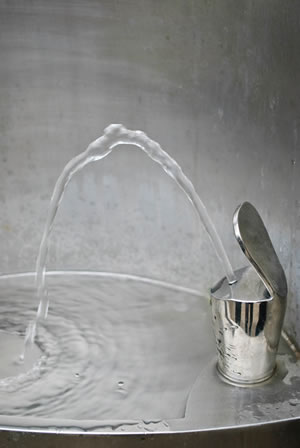Bad Water

PHOTO © JACINTAPHOTO
The crisis in Flint, MI, has brought drinking
water safety to the forefront of everybody’s minds.
College facilities departments have had to answer
questions and send out letters about their water
quality and protocols. Considering the health impact of
lead and other impurities it’s no wonder people are asking
what colleges and universities are doing to keep students,
faculty and staff safe.
Lead is a serious health issue. The EPA states that, “Lead is
a toxic metal that can be harmful to human health even at low
exposure levels.” The organization requires action be taken
when levels reach 15 parts per billion. The heavy metal causes
behavior and learning problems in children, along with slowed
growth and lowered IQ. Adults can suffer from cardiovascular
effects, decreased kidney function and reproductive problems.
Old, corroding pipes and solder can release lead into drinking water. In the case of Flint, switching the water
source from Lake Huron to the highly corrosive Flint River
triggered the release of lead along with other contaminants
into the city’s supply. Since the incident came to light, area
colleges have stepped up testing and are making a concerted
effort to reach out to students and parents.
The University of Michigan–Flint (UM–Flint) has been
testing their campus drinking water since October 2014. By
January 2015 they committed to monthly testing and keep their
community informed with a comprehensive website (www.umflint.edu/campus-water/campus-water-information) and
emails. While testing revealed the school was safe from lead, it
did find elevated levels of trihalomethanes (TTHMs).
A byproduct of disinfecting water with chlorine, long-term
exposure to TTHMs increases the
risk of certain cancers, causes reproductive
issues and can damage the heart, lungs,
kidneys, liver and the central nervous
system. Since this crisis came to light UM–Flint has replaced fixtures and pipes, installed filters and
converted water fountains to filtered bottle refill/drinking
stations. They have installed filtered water stations throughout
campus and have distributed filters to members of the
surrounding community.
GUILT BY ASSOCIATION
Kettering University is located in Flint but as the water
infrastructure that supplies it is reasonably modern with
high flow rates and no lead-copper transitions in the supply
lines, they have not had a problem with contamination.
However, they have had lots of questions and concerns,
prompting University President Robert McMahan to send
out letters to parents, alumni and students about the safety
of the water. McMahan has even criticized the media for
spreading “a great deal of misinformation” about the water,
as reported by the Detroit Free Press.
Still, the university continues to test water and report
results. They also report using filters, flushing food service
water source lines for at least five minutes and only using
cold water for cooking.
PAST PROBLEMS
Lead in drinking water is not a new issue. The University
of Regina in the Canadian province of Saskatchewan had
a lead scare in August of 2012 when samples taken from
drinking fountains showed an elevated level of the metal.
While the levels were below Health Canada’s recommendation
of 0.020 milligrams per liter for a nonresidential site,
the school took immediate action.
Drinking fountains were immediately shut down and replaced
with water coolers. Repairs were made to plumbing and
an older sink and fountain were removed entirely. The entire
building was flushed and a heavy metal filter was installed.
University officials blame the age of the historic College
Avenue Campus building for the presence of lead. They
tested the water quality quarterly for a year and then moved
to annual testing.
A WORLD AWAY
Cornell University, in Ithaca, NY, posts about their water
use, testing and conservation policies online. They report
that conservation measures have reduced consumption
by half since the early 1970s despite almost doubling their
campus building square footage. While they are proud of
that, along with their entire water program,
Christopher Bordlemay, Water/Wastewater
manager, reports that recent events have
trained a spotlight on the operation. He
stopped to answer a few questions.
Flint’s water crisis has put the spotlight on water systems
everywhere. Did Cornell receive an uptick on questions about
water safety in the last few months?
“Yes, we have received calls from concerned customers.
We are fortunate that Cornell’s water quality is excellent and
we do not have issues with lead in our water system.”
You have outlined your robust water safety and conservation
program on-line. Is that in response to the situation in
Flint? Have any of your protocols changed since their crisis?
“Cornell has published water safety and conservation
program information online for many years. We also post an
annual Water Quality Report online. Because Cornell already
had a lead- and copper-monitoring program in place that
meets all regulatory standards, it was not necessary to change
any of our protocols in response to the crisis in Flint. However,
we understand the heightened sensitivity and take great
care in answering any questions from the local community.”
What are the major water safety challenges to a 151-yearold
institution like Cornell and how do you address them?
“Our biggest challenge is replacing and updating aging infrastructure.
We are very fortunate to have capital programs in
place to accomplish this task sequentially and strategically. Cornell
has invested significant resources in plant modernization
and distribution system improvement, and expects to continue
to maintain a very safe, reliable, and efficient water system.”
One thing is for certain: the water crisis in Flint, MI,
has brought to the forefront concern over the quality and
upkeep of public water sources, and colleges and universities
across the country are working to ensure their students,
staff and visitors that they are maintaining clean, healthy
water for everyone on campus.
This article originally appeared in the issue of .